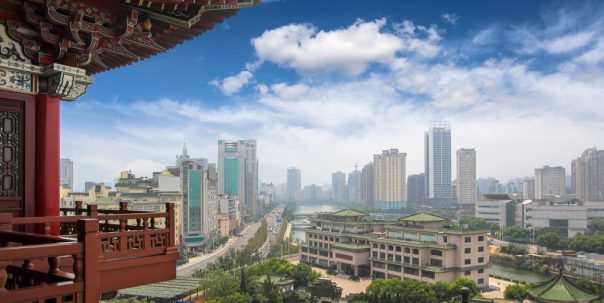THIS MATERIAL IS A MARKETING COMMUNICATION.
Economic Perspectives: Can the Stimulus Package Revive the Indian Economy?
Since the outbreak of COVID-19, the Indian government has implemented extreme lockdown measures in an attempt to limit the spread of the pandemic. As of May 18, 2020, the number of confirmed cases stands at 90,927 with 2,872 deaths. Daily cases are growing around 6% 5-day Compound Daily Growth Rate (“CDGR”). Recent data suggest that active cases are trending lower than total cases at a rate of 5% with recoveries growing faster than new cases. Testing is also increasing at 85-95K per day (May 13, 2020).
There has been a steady increase in recovery rates with the ratio of recovered cases and confirmed cases at 38% as of May 16. Other than Maharashtra and Tamil Nadu, where are among states with more than 1,000 reported cases, many other states have seen a decline in active cases as well as an increase in recovery rates. As of May 16, the overall fatality rate was 3.2%. This figure is relatively low in comparison with other developed countries like the United States, Italy, France, and the United Kingdom.
India’s New Self Reliance
To fight the economic challenges posed by the COVID-19 crisis, as well as leverage the structural opportunities, the Indian government recently launched ‘Atmanirbhar Bharat Abhiyan’ or Self-Reliant India Mission a Rs20.9tn (US$275bn) program. The program includes several relief measures and long-term structural reforms. However, some of the announcements could be re-iterations of reforms that are already underway.
The initial fiscal measure of Rs1.9tn (US$25bn) was intended to buffer the impact of the lockdown through a series of income support measures including cash transfers, free food grain, and gas cylinders and interest-free loans to help low-income households through the lockdown. On the monetary front, RBI liquidity measures amounted to Rs8tn (US$105bn).
Further fiscal measures were later announced, bringing the overall sum of the five tranches to Rs11tn (US$147bn) or 5.2% of GDP. In terms of the overall economic package, the final sum comes to Rs20.9tn (US$275bn) or 10.1% of GDP in addition to the initial measures.
In our view, the immediate net fiscal impact from the overall economic package will be limited at 0.7% of GDP. The room for further fiscal measures is low, given the increasing fiscal deficit.
In effect, the immediate fiscal multiplier effect of these measures will be limited in the near term. We believe the overall stance of measures announced has focused on improving liquidity, enhancing credit facilities, reducing risk aversion in the lending sector, and initiating reforms that enhance the medium-term growth dynamic.

The Indian Stimulus package has been dubbed the largest stimulus plan seen among developing countries post COVID-19. The rollout is expected to create a self-reliant Indian economy by leveraging the nation’s demographic advantages, technological skills and boost domestic demand through robust supply chains as well as building infrastructure, further cementing the “Make in India” campaign.
The promised stimulus package is expected to address fifteen measures, of which six for Micro, Small, and Medium Enterprises MSME’s, two relating to employee provident funds, two for the financial sector, one for real estate, one for power distribution companies and the other three will be tax-related measures.
Stimulus Measures for Micro, Small, and Medium Enterprises (MSME)
Collateral-free automatic loans of Rs3tn (US$39.5bn) as an emergency credit line for small businesses. The loan will cover lenders (banks and non-banking finance companies) on both principal and interest as a guarantee.
Rs200bn (US$2.6bn) of subordinated debt for stressed MSME’s.
Rs100bn (US$1.3bn) fund of funds for MSME’s that are looking to grow or be listed in the future.
We believe the measures implemented for MSMEs will largely keep these businesses afloat in the near-term and should cushion the effects of lockdown laws as a result of COVID. With the majority of the Indian market comprising of MSME, the stimulus package is expected to benefit over 63 million industries.
Measures for Employee Provident Fund (EPF)
Contribution to be paid by the government, providing liquidity support benefiting 7.2 million employees.
Statutory provident fund contribution reduced by 2% to 10% to provide employers more liquidity.
Measures for the Financial Sector
Under a special liquidity scheme to keep non-banking finance companies afloat, the government will buy investment-grade debt (fully guaranteed by the government) from the open market and/or primary route.
The existing partial credit guarantee scheme scope will be expanded with an outlay of Rs450bn (US$6bn). To ensure that all finance companies have access to funds, for AA-rated or below unpaid debt, the government will bear the first 20% loss.
Measures for Power Distribution Companies
Public sector lenders Power Finance Corp (“PFC”) and Rural Electrification Corporation (“REC”) will inject Rs900bn (US$12bn) in power distribution companies. These loans will be used to pay down pending dues of power generating and transmitting companies. State governments will guarantee the loans, that is favorable for the power sector as a whole.
We are positive with the government’s efforts to provide ample liquidity into the market as a liquidity crunch was a big overhang on investor’s minds. The government guarantee and partial credit guarantee scheme should provide the confidence needed, and the expectation is for flows to start returning once sentiment grows positive again slowly.
In line with the adage that a crisis should never go to waste, the Indian government has taken the opportunity to push through much needed Structural Reforms.
Agricultural Reform - The agriculture marketing reform includes amendment of laws at a central and State level to allow farmers to sell their products anywhere they want, including to other states. Previously, farmers were barred from selling inter-state, even if a product price in that State was higher. With the relaxation of this law, we see an increased benefit for consumers as well as farmers. Another reform announced was the removal of agricultural products from the ambit of the Essential Commodities Act, which will allow stock limits to be applied only during emergencies or removed altogether for food processors. This move will free up the industry for farmers and large scale corporate investments, allowing the agricultural market to trade at equilibrium.
Labor Law Reforms - Several states like Uttar Pradesh, Madhya Pradesh, and Gujarat, announced the suspension of crucial labor laws around collective bargaining rights, attaining government approval for dismissals, and factory labor inspection visits for three or more years. In the past, archaic labor laws and frequent harassment by inspectors were cited by the industry as critical deterrents to expand rapidly in India.
Opening Up of State Controlled Sectors and Privatization – Reforms for the coal, defense, and power distribution sector were announced. In terms of coal, the government stated liberalization where any party can now bid for coal blocks. The change comes from the previously monopolized market where only captive mines with end-use ownership could bid.
Defense Sector Push – The government will raise the automatic foreign direct investment (“FDI”) limit to 74 percent from the current 49 percent. There is a push toward domestic manufacturing.
State Incentives for Implementing Reforms - The central government has allowed 200bps additional borrowing for states in FY21. However, it is important to note that 150bps of this is linked to 10 specific targets, including One-Nation-One-Ration Card, ease of doing business, power sector reforms, urban local body reforms, and allowing inter-state use of food subsidies. In the past, measures announced from New Delhi were not always followed through with the same zeal on a state level when local oversight and implementation were key for their success.
The reforms have largely seen around labor, agriculture, and privatization, in our opinion, will create a stronger, more sustainable long-term growth story for India. Although consensus expectation was for there to be a more fiscal stimulus, we recognize that the room for the higher fiscal deficit is limited, and measures were designed with a longer-term outlook.
“Make in India” Campaign
Make in India was gaining momentum pre-COVID. The expectation post-COVID is with realignment in global manufacturing; India could potentially benefit from the shift in manufacturing and supply chains by offering comparable or better terms than other competing regional countries in South/South-East Asia. The anticipation for global companies diversifies away from Chinese manufacturing bases, due to heightened concerns around the deterioration of trade talks with the US as well as refraining from over-reliance on a particular country.
On the supply-side reforms in ‘Ease of Doing Business,’ there has been significant progress with India gaining 71 places higher in the World Bank’s annual ‘Ease of Doing Business’ survey, given the past six years of the central government’s progress in moving forward reforms. A competitive edge the country has is in the new corporate tax rate of 15% for new manufacturing companies. This rate is lower than that of China and other regional countries.
With the combination of the fiscal stimulus along with major policy reforms, we believe the long-term structural growth story for India is laying down a strong foundation for the future. We draw comfort in seeing the necessary measures taken by the government to solidify the Make in India program and believe as the recovery story comes underway, the potential for returns in India remains largely untapped. Positioning ourselves to capture this wave before it is realized is our priority; we need to ensure we see past short-term volatility to reap the long-term benefits.
Since early March 2020, we have seen sharp sell-off and high-risk aversion in Indian markets as investors doubted the ability of the country to handle the COVID outbreak. As the lockdown ends and with no significant second wave of infections, we believe consumers will gradually resume their normal livelihoods, as seen in Korea, Taiwan, and Hong Kong. Thus the market would focus back on business models, growth opportunity, and valuation led risk-reward resulting in outperformance by our portfolio exposures, which are sector-leading companies in financials, insurance, consumer discretionary, real estate, and hospitals. These companies are down nearly 30-50% from February-end and should outperform as they enjoy benefits of growth recovery and market share gains.
Disclaimer & Information for Investors
No distribution, solicitation or advice: This document is provided for information and illustrative purposes and is intended for your use only. It is not a solicitation, offer or recommendation to buy or sell any security or other financial instrument. The information contained in this document has been provided as a general market commentary only and does not constitute any form of regulated financial advice, legal, tax or other regulated service.
The views and information discussed or referred in this document are as of the date of publication. Certain of the statements contained in this document are statements of future expectations and other forward-looking statements. Views, opinions and estimates may change without notice and are based on a number of assumptions which may or may not eventuate or prove to be accurate. Actual results, performance or events may differ materially from those in such statements. In addition, the opinions expressed may differ from those of other Mirae Asset Global Investments’ investment professionals.
Investment involves risk: Past performance is not indicative of future performance. It cannot be guaranteed that the performance of the Fund will generate a return and there may be circumstances where no return is generated or the amount invested is lost. It may not be suitable for persons unfamiliar with the underlying securities or who are unwilling or unable to bear the risk of loss and ownership of such investment. Before making any investment decision, investors should read the Prospectus for details and the risk factors. Investors should ensure they fully understand the risks associated with the Fund and should also consider their own investment objective and risk tolerance level. Investors are advised to seek independent professional advice before making any investment.
Sources: Information and opinions presented in this document have been obtained or derived from sources which in the opinion of Mirae Asset Global Investments (“MAGI”) are reliable, but we make no representation as to their accuracy or completeness. We accept no liability for a loss arising from the use of this document.
Products, services and information may not be available in your jurisdiction and may be offered by affiliates, subsidiaries and/or distributors of MAGI as stipulated by local laws and regulations. Please consult with your professional adviser for further information on the availability of products and services within your jurisdiction. This document is issued by Mirae Asset Global Investments (HK) Limited and has not been reviewed by the Securities and Futures Commission.
Information for EU investors pursuant to Regulation (EU) 2019/1156: This document is a marketing communication and is intended for Professional Investors only. A Prospectus is available for the Mirae Asset Global Discovery Fund (the “Company”) a société d'investissement à capital variable (SICAV) domiciled in Luxembourg structured as an umbrella with a number of sub-funds. Key Investor Information Documents (“KI(I)Ds”) are available for each share class of each of the sub-funds of the Company.
The Company’s Prospectus and the KI(I)Ds can be obtained from www.am.miraeasset.eu/fund-literature . The Prospectus is available in English, French, German, and Danish, while the KI(I)Ds are available in one of the official languages of each of the EU Member States into which each sub-fund has been notified for marketing under the Directive 2009/65/EC (the “UCITS Directive”). Please refer to the Prospectus and the KI(I)D before making any final investment decisions.
A summary of investor rights is available in English from www.am.miraeasset.eu/investor-rights-summary/.
The sub-funds of the Company are currently notified for marketing into a number of EU Member States under the UCITS Directive. FundRock Management Company can terminate such notifications for any share class and/or sub-fund of the Company at any time using the process contained in Article 93a of the UCITS Directive.
Hong Kong: It is intended is for Hong Kong investors. Before making any investment decision to invest in the Fund, Investors should read the Fund’s Prospectus and the information for Hong Kong investors (of applicable) of the Fund for details and the risk factors. The individual and Mirae Asset Global Investments (Hong Kong) Limited may hold the individual securities mentioned. This document is issued by Mirae Asset Global Investments (HK) Limited and has not been reviewed by the Securities and Futures Commission.
Singapore: It is not intended for general public distribution. The investment is designed for Institutional investors and/or Accredited Investors as defined under the Securities and Futures Act of Singapore. This document is issued by Mirae Asset Global Investments (HK) Limited and has not been reviewed by the Monetary Authority of Singapore. Please consult with your professional adviser for further information on the availability of products and services within your jurisdiction.
Australia: The information contained in this document is provided by Mirae Asset Global Investments (HK) Limited (“MAGIHK”), which is exempted from the requirement to hold an Australian financial services license under the Corporations Act 2001 (Cth) (Corporations Act) pursuant to ASIC Class Order 03/1103 (Class Order) in respect of the financial services it provides to wholesale clients (as defined in the Corporations Act) in Australia. MAGIHK is regulated by the Securities and Futures Commission of Hong Kong under Hong Kong laws, which differ from Australian laws. Pursuant to the Class Order, this document and any information regarding MAGIHK and its products is strictly provided to and intended for Australian wholesale clients only. The contents of this document is prepared by Mirae Asset Global Investments (HK) Limited and has not been reviewed by the Australian Investments & Securities Commission.
Swiss investors: This document is intended for Professional Investors only. This is an advertising document. The Swiss Representative is 1741 Fund Solutions AG, Burggraben 16, CH-9000 St. Gallen. The Swiss Paying Agent is Tellco AG, Bahnhofstrasse 4, CH-6431 Schwyz. The Prospectus and the Supplements of the Funds, the KI(I)Ds, the Memorandum and Articles of Association as well as the annual and interim reports of the Company are available free of charge from the Swiss Representative.
UK investors: This document is intended for Professional Investors only. The Company is a Luxembourg registered UCITS, recognised in the UK under section 264 of the Financial Services and Markets Act 2000. Compensation from the UK Financial Services Compensation Scheme will not be available in respect of the Fund. The taxation position affecting UK investors is outlined in the Prospectus.
Copyright 2025. All rights reserved. No part of this document may be reproduced in any form, or referred to in any other publication, without express written permission of Mirae Asset Global Investments (Hong Kong) Limited.


















